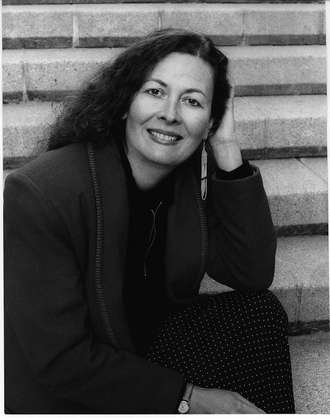Editor’s Note: As we approach our tenth year of publishing Fiction Writers Review, we’ve decided to curate a series of “From the Archives” posts that we’ll re-publish each week or so during the year. Some of these features are editor favorites, some tie in with a new book out from an author whose work we’ve covered in the past, and some are first conversations with debut authors who are now household names.
This week we’ve returned to Rosalie Morales Kearns’s Stories We Love post on Kathleen Alcalá’s “Ghostwriting for the Archbishop,” which we originally published on May 21 of 2014.
In the 1990s, as I was fumbling my way toward becoming a writer, what I knew about literary fiction mostly came from the New York Times Book Review, and it seemed to me that all the celebrated authors were working in the realist tradition.
In college I had read some Borges in the original Spanish, some Gogol in the original Russian, but those authors seemed long ago and far away. What I saw validated was realism. That’s what I felt I had to aim for as a writer.
Then in a used bookstore one day I came across an anthology entitled Black Water: The Book of Fantastic Literature (Three Rivers Press, 1984), edited by Alberto Manguel, and realized that this was the way I truly wanted to write.
What Latin Americans call “the fantastic” encompasses not only magic realism (or fabulism, slipstream, etc.) but also elements of the surreal, the absurd, the uncanny, or just the weird narrative logic of many of Borges’s works. Writing in this mode allows me to tell stories that feel more true than realism, allows me to adjust the lens, so to speak. It provides the opportunity to play.
And it can be very, very funny.
Which brings me to Kathleen Alcalá’s story collection Mrs. Vargas and the Dead Naturalist (1993), published by the small feminist press Calyx Books. I discovered the book soon after reading Black Water, and it reinforced my resolve to play with a magic realist lens myself.
In my favorite piece from the collection, “Ghostwriting for the Archbishop,” the action consists mostly of the mild-mannered Archbishop at his desk, reading correspondence, signing paperwork. Occasionally, letters addressed to a mysterious woman named Joanna show up for his signature. He dutifully signs them. He has vague memories of an auburn-haired woman, wonders if that’s Joanna. Wonders if he’s in love with Joanna. While reading a budget report one day, he hops off his balcony and flies around the city, then returns to his desk, pleased at his newfound ability. Another day, he finally decides to find out who is writing these letters, and heads down the hall toward the ghostwriter’s office.
Yes, I did say he flies around the city. I’ll get back to that later.
The Archbishop is a holy innocent, reminding me somewhat of the title character of Graham Greene’s Monsignor Quixote. He says the prayers that the letter writers ask him to say. He winces at the moneygrubbing maneuvers of the archdiocesan bureaucracy. His mind tends to wander: when he thinks sadly of the recent death of a friend who had been a skiing partner of his, he’s immediately distracted by imagining himself on the ski slopes.
There are so many things writers can learn from the story, even those who aren’t interested in writing in the magic realist vein themselves. One is the use of a truly omniscient narrative voice, rather than the very close third-person-limited that’s often found in realist work. This allows the author to convey the thoughts of other characters (another priest, the secretary, a bird that lands on his desk) and to vary the narrative distance from the Archbishop, sometimes delving into his thoughts and other times observing him from the outside, in ways that he himself wouldn’t do.
The Archbishop often receives letters which are actually addressed to St. Jude. Petitioners consider the Archbishop to be further along in the chain of command, . . . and so better able to convey their prayers to a higher authority. He reads all of their prayers over carefully. . . . Faith is a powerful thing, and the Archbishop is not one to stand in the way of a blessing.
The omniscient voice doesn’t judge the Archbishop or mock him, but simply reports his activities and thought processes with a solemnness that in fact contributes to the gently absurdist tone.
Another of Alcalá’s strengths is knowing what to leave unsaid. For example, while the baffling letters to Joanna are mentioned right away, we don’t see the contents of a letter till the fourth page of the story. And we don’t get to read the final letter at all, the one that convinces the Archbishop that he must find “the ghostwriter” and learn more about Joanna.
The letters to Joanna don’t qualify as magical–their origin is mysterious, but not otherworldly. (“The memory of your sweet breath lingers with me,” begins one letter. “Although it’s only been two weeks, it feels like two years since I last saw you.” And in another letter: “Your eyes light up the sky, your hips move like the swaying leaves of a tree on a summer day.”) What’s bizarre is the Archbishop’s reaction to them: he doesn’t know Joanna but still signs the letters:
He assumes the correspondence with her is important, or he would not be asked to sign these letters. He has never seen a letter from Joanna, . . . and wonders how she responds to these lavish and rather intimate compliments. . . . Oh, Joanna, he thinks. Dear, sweet Joanna. Who are you?
This lack of surprise or curiosity is consistent with the Archbishop’s response to the clearly “magical” elements of the story: Red roses fall out of nowhere (evoking Our Lady of Guadalupe, though the Archbishop thinks of a more recent apparition of the Virgin Mary, at Medjugorje). A bird lands on the Archbishop’s desk and cries “Peace of Christ!” The Archbishop flies around the city:
Raising his arms [after jumping off his balcony], the Archbishop finds that he can soar upward, and he passes low over the spires of the cathedral as workmen on the roof gape up at him. The Archbishop circles once and heads out over the lake. He is having a wonderful time.
At the end, the story takes yet another unexpected turn. The archbishop has burst out of his office, demanding to know where the ghostwriter is. His startled secretary points to a closed door at the end of a hall. What the Archbishop sees when he opens the door is the subject of the final paragraph, which begins:
At the very back of the room, behind a glass partition, a single light is burning. As the Archbishop approaches, he sees an auburn-haired woman bending over my shoulder. He cannot see our faces.
 Here, in one of the most striking passages of this brilliant story, the omniscient narrative voice has switched to the first person, in fact has become a character, accompanied by another character who was merely a dim memory of the Archbishop’s.
Here, in one of the most striking passages of this brilliant story, the omniscient narrative voice has switched to the first person, in fact has become a character, accompanied by another character who was merely a dim memory of the Archbishop’s.
Every time I read this story I get a thrill, the sensation of having to hold on tight for a wild, plummeting ride, a dizzying shift in perspective, a cascade of questions that I can’t answer. I love it and I’m still mystified by it, and I savor the feeling.






